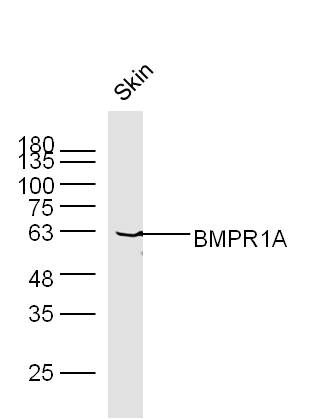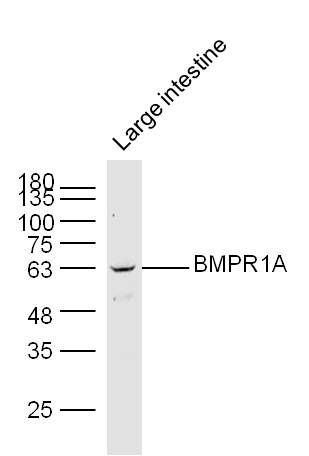中文名称骨成型蛋白受体1A抗体
别 名BMPR-1A; Activin A receptor type II like kinase 3; Activin receptor like kinase 3; ACVRLK 3; ACVRLK3; ALK 3; ALK3; BMPR 1A; Bmpr; Bone morphogenetic protein receptor type IA; Bone morphogenetic protein receptor type IA precursor; BR 1a; BR1a; CD 292; CD292; CD292 antigen; EC 2.7.11.30; Serine threonine protein kinase receptor R5; Serine threonine protein kinase receptor R5 precursor; SKR 5; SKR5; zBMPR IA; zBMPRIA.
研究领域肿瘤 心血管 细胞生物 信号转导 干细胞 生长因子和激素 转录调节因子 激酶和磷酸酶 细胞膜受体 细胞表面分子
抗体来源Rabbit
克隆类型Polyclonal
交叉反应Mouse, Rat, (predicted: Human, )
产品应用WB=1:500-2000 ELISA=1:500-1000
not yet tested in other applications.
optimal dilutions/concentrations should be determined by the end user.
分 子 量60kDa
细胞定位细胞膜
性 状Liquid
浓 度1mg/ml
免 疫 原KLH conjugated synthetic peptide derived from human BMPR-1A:101-200/532
亚 型IgG
纯化方法affinity purified by Protein A
储 存 液0.01M TBS(pH7.4) with 1% BSA, 0.03% Proclin300 and 50% Glycerol.
保存条件Shipped at 4℃. Store at -20 °C for one year. Avoid repeated freeze/thaw cycles.
PubMedPubMed
产品介绍The bone morphogenetic protein (BMP) receptors are a family of transmembrane serine/threonine kinases that include the type I receptors BMPR1A and BMPR1B and the type II receptor BMPR2. These receptors are also closely related to the activin receptors, ACVR1 and ACVR2. The ligands of these receptors are members of the TGF-beta superfamily. TGF-betas and activins transduce their signals through the formation of heteromeric complexes with 2 different types of serine (threonine) kinase receptors: type I receptors of about 50-55 kD and type II receptors of about 70-80 kD. Type II receptors bind ligands in the absence of type I receptors, but they require their respective type I receptors for signaling, whereas type I receptors require their respective type II receptors for ligand binding. [provided by RefSeq].
Function:
On ligand binding, forms a receptor complex consisting of two type II and two type I transmembrane serine/threonine kinases. Type II receptors phosphorylate and activate type I receptors which autophosphorylate, then bind and activate SMAD transcriptional regulators. Receptor for BMP-2 and BMP-4.
Subcellular Location:
Membrane; Single-pass type I membrane protein.
Tissue Specificity:
Highly expressed in skeletal muscle.
DISEASE:
Defects in BMPR1A are a cause of juvenile polyposis syndrome (JPS) [MIM:174900]; also known as juvenile intestinal polyposis (JIP). JPS is an autosomal dominant gastrointestinal hamartomatous polyposis syndrome in which patients are at risk for developing gastrointestinal cancers. The lesions are typified by a smooth histological appearance, predominant stroma, cystic spaces and lack of a smooth muscle core. Multiple juvenile polyps usually occur in a number of Mendelian disorders. Sometimes, these polyps occur without associated features as in JPS; here, polyps tend to occur in the large bowel and are associated with an increased risk of colon and other gastrointestinal cancers.
Defects in BMPR1A are a cause of Cowden disease (CD) [MIM:158350]. CD is an autosomal dominant cancer syndrome characterized by multiple hamartomas and by a high risk for breast, thyroid and endometrial cancers.
Similarity:
Belongs to the protein kinase superfamily. TKL Ser/Thr protein kinase family. TGFB receptor subfamily.
Contains 1 GS domain.
Contains 1 protein kinase domain.
SWISS:
P36894
Gene ID:
657
Database links:
Entrez Gene: 657 Human
Entrez Gene: 12166 Mouse
Entrez Gene: 81507 Rat
Omim: 601299 Human
SwissProt: P36894 Human
SwissProt: P36895 Mouse
SwissProt: Q78EA7 Rat
Unigene: 524477 Human
Unigene: 237825 Mouse
Unigene: 88925 Rat
Important Note:
This product as supplied is intended for research use only, not for use in human, therapeutic or diagnostic applications.
| 产品图片 | Sample:
Skin (Mouse) Lysate at 40 ug
Primary: Anti-BMPR1A (bs- 1509R) at 1/300 dilution
Secondary: IRDye800CW Goat Anti-Rabbit IgG at 1/20000 dilution
Predicted band size: 60 kD
Observed band size: 63 kD Sample:
Placenta (Mouse) Lysate at 40 ug
Primary: Anti-BMPR1A (bs- 1509R) at 1/300 dilution
Secondary: IRDye800CW Goat Anti-Rabbit IgG at 1/20000 dilution
Predicted band size: 60 kD
Observed band size: 63 kD Sample:
Large intestinal (Mouse) Lysate at 40 ug
Primary: Anti-BMPR1A (bs- 1509R) at 1/300 dilution
Secondary: IRDye800CW Goat Anti-Rabbit IgG at 1/20000 dilution
Predicted band size: 60 kD
Observed band size: 63 kD Sample:
Lane1:Brain(Rat) Lysate at 30 ug
Lane2: Intestine(Mouse) Lysate at 30 ug
Primary: Anti-BMPR1A/CD292 (bs-1509R) at 1:200 dilution;
Secondary: HRP conjugated Goat Anti-Rabbit IgG(bs-0295G-HRP) at 1:3000 dilution;
Predicted band size : 60kD
Observed band size : 59 kD |


